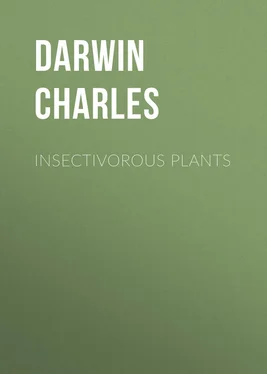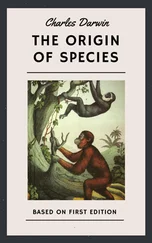Charles Darwin - Insectivorous Plants
Здесь есть возможность читать онлайн «Charles Darwin - Insectivorous Plants» — ознакомительный отрывок электронной книги совершенно бесплатно, а после прочтения отрывка купить полную версию. В некоторых случаях можно слушать аудио, скачать через торрент в формате fb2 и присутствует краткое содержание. Жанр: foreign_antique, foreign_prose, на английском языке. Описание произведения, (предисловие) а так же отзывы посетителей доступны на портале библиотеки ЛибКат.
- Название:Insectivorous Plants
- Автор:
- Жанр:
- Год:неизвестен
- ISBN:нет данных
- Рейтинг книги:5 / 5. Голосов: 1
-
Избранное:Добавить в избранное
- Отзывы:
-
Ваша оценка:
- 100
- 1
- 2
- 3
- 4
- 5
Insectivorous Plants: краткое содержание, описание и аннотация
Предлагаем к чтению аннотацию, описание, краткое содержание или предисловие (зависит от того, что написал сам автор книги «Insectivorous Plants»). Если вы не нашли необходимую информацию о книге — напишите в комментариях, мы постараемся отыскать её.
Insectivorous Plants — читать онлайн ознакомительный отрывок
Ниже представлен текст книги, разбитый по страницам. Система сохранения места последней прочитанной страницы, позволяет с удобством читать онлайн бесплатно книгу «Insectivorous Plants», без необходимости каждый раз заново искать на чём Вы остановились. Поставьте закладку, и сможете в любой момент перейти на страницу, на которой закончили чтение.
Интервал:
Закладка:
Charles Darwin
Insectivorous Plants
CHAPTER I
Number of insects captured – Description of the leaves and their appendages or tentacles – Preliminary sketch of the action of the various parts, and of the manner in which insects are captured – Duration of the inflection of the tentacles – Nature of the secretion – Manner in which insects are carried to the centre of the leaf – Evidence that the glands have the power of absorption – Small size of the roots.
During the summer of 1860, I was surprised by finding how large a number of insects were caught by the leaves of the common sun-dew (Drosera rotundifolia) on a heath in Sussex. I had heard that insects were thus caught, but knew nothing further on the subject. 1 1 As Dr. Nitschke has given ('Bot. Zeitung,' 1860, p. 229) the bibliography of Drosera, I need not here go into details. Most of the notices published before 1860 are brief and unimportant. The oldest paper seems to have been one of the most valuable, namely, by Dr. Roth, in 1782. There is also an interesting though short account of the habits of Drosera by Dr. Milde, in the 'Bot. Zeitung,' 1852, p. 540. In 1855, in the 'Annales des Sc. nat. bot.' tom. iii. pp. 297 and 304, MM. Groenland and Trcul each published papers, with figures, on the structure of the leaves; but M. Trcul went so far as to doubt whether they possessed any power of movement. Dr. Nitschke's papers in the 'Bot. Zeitung' for 1860 and 1861 are by far the most important ones which have been published, both on the habits and structure of this plant; and I shall frequently have occasion to quote from them. His discussions on several points, for instance on the transmission of an excitement from one part of the leaf to another, are excellent. On December 11, 1862, Mr. J. Scott read a paper before the Botanical Society of Edinburgh, [] which was published in the 'Gardeners' Chronicle,' 1863, p. 30. Mr. Scott shows that gentle irritation of the hairs, as well as insects placed on the disc of the leaf, cause the hairs to bend inwards. Mr. A.W. Bennett also gave another interesting account of the movements of the leaves before the British Association for 1873. In this same year Dr. Warming published an essay, in which he describes the structure of the so-called hairs, entitled, "Sur la Diffrence entre les Trichomes," &c., extracted from the proceedings of the Soc. d'Hist. Nat. de Copenhague. I shall also have occasion hereafter to refer to a paper by Mrs. Treat, of New Jersey, on some American species of Drosera. Dr. Burdon Sanderson delivered a lecture on Dionaea, before the Royal Institution published in 'Nature,' June 14, 1874, in which a short account of my observations on the power of true digestion possessed by Drosera and Dionaea first appeared. Prof. Asa Gray has done good service by calling attention to Drosera, and to other plants having similar habits, in 'The Nation' (1874, pp. 261 and 232), and in other publications. Dr. Hooker, also, in his important address on Carnivorous Plants (Brit. Assoc., Belfast, 1874), has given a history of the subject.
I gathered by chance a dozen plants, bearing fifty-six fully expanded leaves, and on thirty-one of these dead insects or remnants of them adhered; and, no doubt, many more would have been caught afterwards by these same leaves, and still more by those as yet not expanded. On one plant all six leaves had caught their prey; and on several plants very many leaves had caught more than a single insect. On one large leaf I found the remains of thirteen distinct insects. Flies (Diptera) are captured much oftener than other insects. The largest kind which I have seen caught was a small butterfly (Caenonympha pamphilus); but the Rev. H.M. Wilkinson informs me that he found a large living dragon-fly with its body firmly held by two leaves. As this plant is extremely common in some districts, the number of insects thus annually slaughtered must be prodigious. Many plants cause the death of insects, for instance the sticky buds of the horse-chestnut (Aesculus hippocastanum), without thereby receiving, as far as we can perceive, any advantage; but it was soon evident that Drosera was excellently adapted for the special purpose of catching insects, so that the subject seemed well worthy of investigation.
The results have proved highly remarkable; the more important ones being – firstly, the extraordinary sensitiveness of the glands to slight pressure and to minute doses of certain nitrogenous fluids, as shown by the movements of the so-called hairs or tentacles; secondly, the power possessed by the leaves of rendering soluble or digesting nitrogenous substances, and of afterwards absorbing them; thirdly, the changes which take place within the cells of the tentacles, when the glands are excited in various ways.
It is necessary, in the first place, to describe briefly the plant. It bears from two or three to five or six leaves, generally extended more or less horizontally, but sometimes standing vertically upwards. The shape and general appearance of a leaf is shown, as seen from above, in fig. 1, and as seen laterally, in fig. 2. The leaves are commonly a little broader than long, but this was not the case in the one here figured. The whole upper surface is covered with gland-bearing filaments, or tentacles, as I shall call them, from their manner of acting. The glands were counted on thirty-one leaves, but many of these were of unusually large size, and the average number was 192; the greatest number being 260, and the least 130. The glands are each surrounded by large drops of extremely viscid secretion, which, glittering in the sun, have given rise to the plant's poetical name of the sun-dew.
[The tentacles on the central part of the leaf or disc are short and stand upright, and their pedicels are green. Towards the margin they become longer and longer and more inclined outwards, with their pedicels of a purple colour. Those on the extreme margin project in the same plane with the leaf, or more commonly (see fig. 2) are considerably reflexed. A few tentacles spring from the base of the footstalk or petiole, and these are the longest of all, being sometimes nearly 1/4 of an inch in length. On a leaf bearing altogether 252 tentacles, the short ones on the disc, having green pedicels, were in number to the longer submarginal and marginal tentacles, having purple pedicels, as nine to sixteen.
A tentacle consists of a thin, straight, hair-like pedicel, carrying a gland on the summit. The pedicel is somewhat flattened, and is formed of several rows of elongated cells, filled with purple fluid or granular matter. 2 2 According to Nitschke ('Bot. Zeitung,' 1861, p. 224) the purple fluid results from the metamorphosis of chlorophyll. Mr. Sorby examined the colouring matter with the spectroscope, and informs me that it consists of the commonest species of erythrophyll, "which is often met with in leaves with low vitality, and in parts, like the petioles, which carry on leaf-functions in a very imperfect manner. All that can be said, therefore, is that the hairs (or tentacles) are coloured like parts of a leaf which do not fulfil their proper office." Dr. Nitschke has discussed this subject in 'Bot. Zeitung,' 1861, p. 241 &c. See also Dr. Warming ('Sur la Diffrence entre les Trichomes' &c., 1873), who gives references to various publications. See also Groenland and Trcul 'Annal. des Sc. nat. bot.' (4th series), tom. iii. 1855, pp. 297 and 303.
There is, however, a narrow zone close beneath the glands of the longer tentacles, and a broader zone near their bases, of a green tint. Spiral vessels, accompanied by simple vascular tissue, branch off from the vascular bundles in the blade of the leaf, and run up all the tentacles into the glands.
Интервал:
Закладка:
Похожие книги на «Insectivorous Plants»
Представляем Вашему вниманию похожие книги на «Insectivorous Plants» списком для выбора. Мы отобрали схожую по названию и смыслу литературу в надежде предоставить читателям больше вариантов отыскать новые, интересные, ещё непрочитанные произведения.
Обсуждение, отзывы о книге «Insectivorous Plants» и просто собственные мнения читателей. Оставьте ваши комментарии, напишите, что Вы думаете о произведении, его смысле или главных героях. Укажите что конкретно понравилось, а что нет, и почему Вы так считаете.












